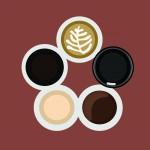From latte art videos on Facebook to not-so-witty quotes on T-shirts, coffee is an indisputable aspect of our everyday lives. Every frappy hour is national news, and liking the taste of coffee is viewed as a mark of adulthood. I don’t claim to be a coffee expert that can easily discern between single-origin coffees and blends. However, I love coffee because of how much it has to offer in regards to its taste, variety, effect and experience. For the rest of the quarter, I will be embarking on an in-depth exploration of coffee from all aspects, and hopefully become more coffee-cultured.
You enter a coffee shop and scan all the choices on the menu while waiting in line. You still have a “new year, new me” mantra so you consider adding some spice into your life by switching up your everyday order of an iced mocha to a cappuccino – but what exactly is a cappuccino? Just as you pull out your phone to consult Google, you’re already at the front of the line, leaving you hastily ordering your usual to play it safe.
If you’re confused by all of the different types of drinks on coffee shop menus, whether it be at Kerckhoff Coffeehouse or Blue Bottle, this article’s for you. Here’s how to navigate the language of specialty coffee drinks.
Espresso
Espresso can be consumed as is, but it is also the foundation of many coffee drinks, which are aptly called espresso-based drinks. A shot of espresso is one ounce, and is made using finely ground espresso beans, hot water and pressure. This results in a concentrated liquid with an intense flavor, allowing it to be used to make other drinks. Espresso beans are usually dark roasted beans, which are very oily and have a full body flavor.
Some of the most common espresso-based drinks are the caffe latte, cappuccino, flat white, macchiato and Americano, in the order of containing the most amount of milk to the least.
Caffe Latte
Although the term latte has become synonymous with coffee, they’re not the same. The literal translation of caffe latte is “coffee milk.” Appropriately, lattes contain the most milk out of these espresso-based drinks, giving them a mild and mellow taste. A latte consists of two-thirds milk, one-third espresso and a layer of foamed milk.
Cappuccino
A cappuccino has less milk than a latte. It is made up of one-third milk, one-third espresso and one-third foamed milk. This gives it a stronger coffee taste than a latte, especially since these three layers are separated, whereas the milk and espresso in a latte are mixed.
Flat White
Out of these drinks, a flat white is probably the most unknown and also the most complicated. It originated in Australia and New Zealand, and is somewhat similar to a latte. However, a flat white consists of two shots of espresso with micro-foamed milk. The espresso and milk are poured in together, which gives it a different texture than that of a latte. Lastly, it is supposed to be 5.5 ounces.
Macchiato
At Starbucks, a macchiato is an aesthetically pleasing drink with a clear separation of espresso and milk, and an ample amount of caramel. However, if you go to less corporate coffee shop, don’t be surprised when your macchiato comes in a tiny cup. Macchiato literally means “marked,” so a macchiato is an espresso shot marked with foamed milk, thus only containing a little amount of milk as opposed to the Starbucks version.
Americano
An Americano consists of only espresso and hot water. Many may find a straight espresso shot to be too overpowering and strong, but diluting it with hot water creates a drink that has a better taste than normal drip coffee. Because of the espresso, Americanos have a richer taste and are less bitter. This is a good option for those who are lactose-intolerant or calorie conscious.
The next time you find yourself at Northern Lights or the Westwood Coffee Bean & Tea Leaf, you can make a more informed decision and discover your new go-to order.
